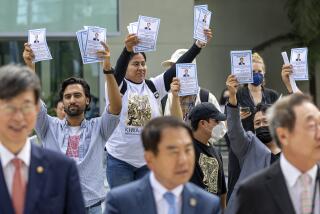With Bank Merger, S. Korea Takes Steps to Revamp Economic System
- Share via
SEOUL — It’s Saturday afternoon and, after a full 5 1/2 days of work, the staffs at Commercial Bank of Korea and Hanil Bank slip into wool jackets, knickers and hiking boots.
A chance to relax, forget the bad loans, shed the economic gloom and doom? Not exactly. It’s time to head for the hills.
In a bid to create South Korea’s first successful bank merger in modern times, the government has sent Hanil and Commercial employees packing--on hikes in the mountains around Seoul--to encourage some major bonding sessions. Slip, slide, schmooze and sweat together, the government reasons, and you reduce the cultural tribalism that has ruined so many past unions in this country.
The shotgun marriage of Commercial and Hanil into a new bank called Hanvit, due to be consummated Monday, is both a symbol and a practical milestone in what South Korea hopes will be its return to the global state as an economic power.
It is through the banks, the government believes, that reform can be forced throughout the economy. The threat to cut off bank credit is emerging as one of the government’s most potent weapons in the showdown with the reform-resistant conglomerates, or chaebol, that dominate the economy.
“The government has a lot of influence over the financial sector, which is key for corporate restructuring,” said Kim Jun Il, senior counselor to the finance minister.
The Commercial-Hanil merger is seen as a key test of whether South Korea’s financial system can do what it has delayed for so long: put itself on a diet; shed unneeded workers and branches; listen to the market, not the government; and look before you lend.
Moreover, healthy, well-capitalized banks are essential to the restructuring process in the rest of the economy as well. A functioning banking system helps ensure that credit keeps flowing to other companies if an influential chaebol starts to falter.
This means cutbacks. Since the merger was announced, the two banks have closed more than one-fourth of their combined 990 branches and slashed the work force to 10,000 from 15,000. It could go as low as 7,000.
While getting the survivors to work together and shed deeply rooted work habits in favor of a new corporate culture is always difficult, this is particularly true in tradition-bound South Korea.
People from both banks acknowledge that they’re fighting the weight of history. The only other major financial merger in recent memory, involving Seoul Bank and Trust Bank in the 1970s, failed spectacularly--a victim of distrust and recriminations.
Many South Korean companies and banks have tended to emphasize market share over profit and demanded deep employee loyalty. Breaking down this outlook and joining forces with past rivals can entail psychological as well as practical changes.
In this case, employees say, the challenge will be to blend 100-year-old Commercial’s conservative, even stodgy, culture with the more “lively” approach of 60-year-old Hanil.
“This is a chemical, not just a physical, merger,” said Kim Kon Soo, a Hanil general manager dressed in a red plaid hat, gaiters and well-worn leather boots. “We’re trying to create that chemistry--to stop saying ‘mine or yours’ and say ‘ours.’ ”
Perhaps the biggest reason for optimism about this merger is the fact that today’s economy has hit a wall and forced everyone to accept more tough choices.
“With Seoul and Trust, there was no incentive to cooperate and people undercut each other,” said Hanil’s Kim. “We can’t afford that. We must make a success of it.”
Their example will set the tone for many more mergers expected in several industries in coming months as South Korea struggles to tackle rampant overcapacity across its economic landscape.
In the financial sector alone, the birth of Hanvit in early 1999 will be quickly followed by the merger of Kookmin and Korean Long-Term Credit Bank; the three-way union of Chohung, Kangwon and Hyundai Merchant banks; and a merger between Hana and Boram banks.
“We have a great responsibility,” said Lee Soon Woo, Commercial’s general manager, reflecting the sense of national stewardship that has prevailed throughout South Korea’s economic crisis. “The success of the Korean banking industry depends on our merger.”
“You can’t deny a culture-clash element, but everyone is more willing to compromise,” said Lee Seung Hoon, banking analyst with Morgan Stanley Dean Witter.
The Financial Supervisory Commission has been able to make relatively quick progress in South Korea’s financial system because it exerts direct control through ownership changes, bailouts and central bank regulations.
Already this year, South Korea either closed or suspended 94 financial institutions, recapitalized many remaining institutions, stabilized the currency and pushed down interest rates.
Now the government is trying to use the banks to tame South Korea’s top five chaebol--Samsung, Hyundai, Daewoo, LG and SK--which account for 37% of all loans made in South Korea. The conglomerates have been widely criticized for crowding out credit, innovation and economic vitality.
On Dec. 28, major banks, under pressure from the government, threatened to cut off loans to LG Semicon Co. for balking at a forced merger with Hyundai Electronics Industries.
Some analysts worry that the FSC and other government agencies could grow too fond of their direct control over the financial sector and refuse to release their grip. Commercial Bank, for instance, is 93% owned by the government, a stake it took in exchange for acquiring $1.25 billion in bad loans.
Another delicate issue is foreign ownership. Top policymakers and foreign analysts say South Korea needs a strong foreign competitor that would force domestic banks to improve their game quickly.
Last week, the government agreed to sell control of heavily indebted Korea First Bank to an American consortium. And in a November visit, Citibank Vice Chairman William Rhodes expressed interest in acquiring several ailing banks, according to presidential spokesman Park Sun Sook.
But because of the banks’ problems here, few foreigners are willing to pay very much. And politically, a low selling price looks like a handout to the foreigners, said Jeffrey D. Jones, president of the Chamber of Commerce in South Korea. “No one wants to be criticized for giving them away,” he added.
Back on the mountain, as the hike begins, the Commercial and Hanil employees greet each other politely but a bit stiffly.
“Of course, there’s anxiety because Hanil’s department has five people and ours has five, and I don’t think they’ll keep everyone,” said Oh Yeon Ju, a broadcaster on Commercial’s internal loudspeaker system.
Little more than 20 yards up the trail, however, the first mobile phone rings and draws a laugh. A few hundred feet later one joker yells out, “We’ve arrived at the top.” “You wish,” several yell back as the bonding begins.
At the first bridge, it’s time to stop for a group photo. Cloth signs magically appear from backpacks that read “New beginning for Hanvit Bank.”
As the group poses, some strangers walk by and ask what a “Hanvit” is. The new bank obviously needs more public relations. “Join us, future customers!” one of the bank employees calls back to them.
As the last rays of sun disappear over the ridge, the group reaches the top of the climb. The way down is much faster and at some unnoticed point along the trail, the barrier between the two groups begins to disappear.
Next it’s on to a local restaurant. After some heaping pots of spicy kim chee and several containers of onion-laced rice wine, faces start turning bright red, gestures become looser and even the shyest members begin leaning on each other. If the body language is any clue, the merger shows promise.
More to Read
Sign up for Essential California
The most important California stories and recommendations in your inbox every morning.
You may occasionally receive promotional content from the Los Angeles Times.













